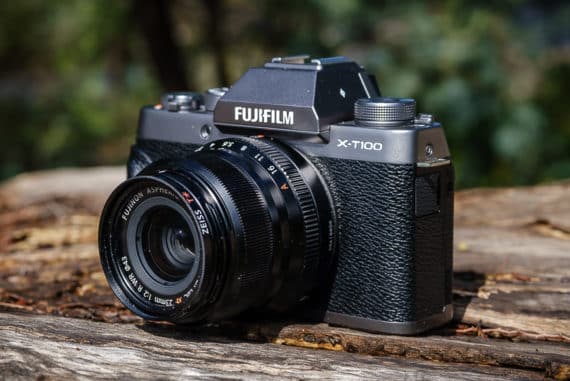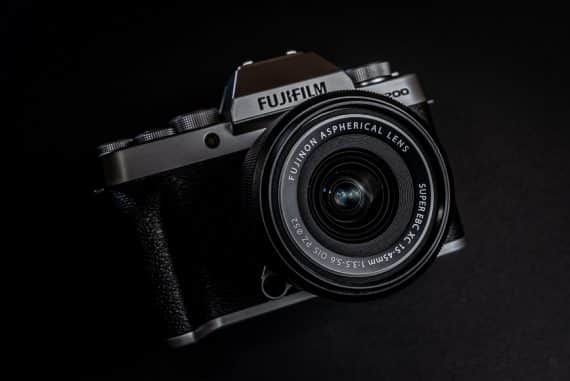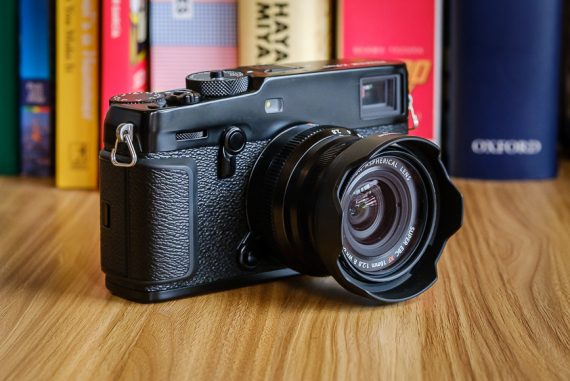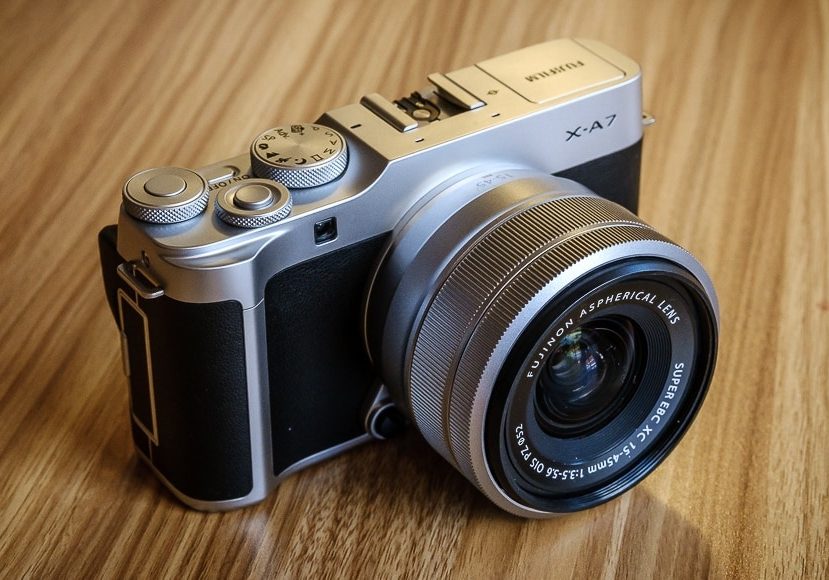
Fujifilm X-A7 Mirrorless Camera Review
When it comes to choosing an excellent mirrorless camera in any price bracket, Fujifilm has a solution. I am sure people could say that of any brand, but having owned and tested a large number of Fujifilm cameras, I can confidently say theirs are exceptional.
The Fujifilm X-A7 is an entry-level camera with an exciting range of features aimed at those that want to step up from shooting with their smartphone. In fact, some of the features I would like to see in their flagship models in the future.
In addition, this is an entry-level camera that serves as an affordable gateway into the whole Fujifilm ecosystem, and all the wonderful Fujifilm X Series lenses on offer.
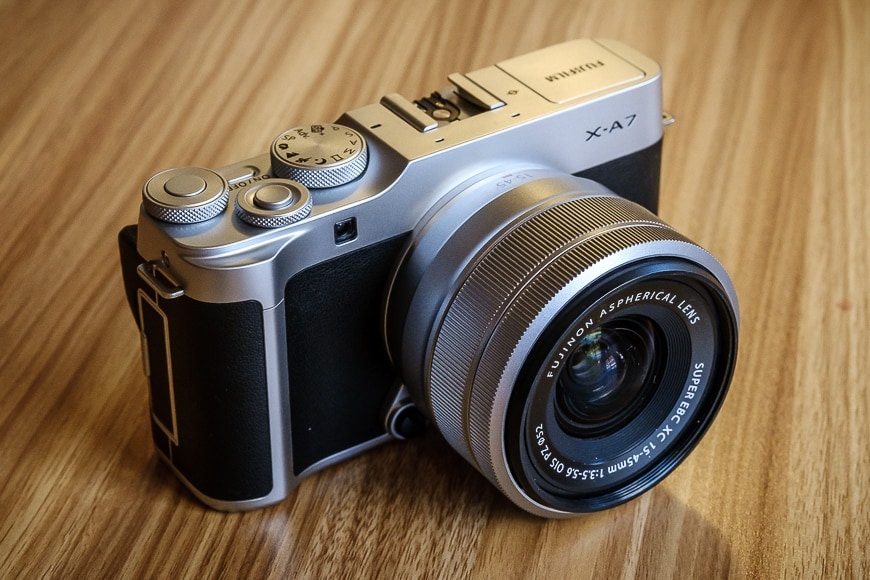
Compact and light, the X-A7 offers impressive performance at an affordable price.
The X-A7 is the next generation of the X-A series, with the X-A5 preceding it. The advancements between the two generations is significant – this camera represents a fantastic first purchase, daily-carry, or even second camera body.
Fujifilm X-A7 Specs
- Minimal and stylish design that is clutter-free.
- Massive 16:9 ratio, highly responsive touch screen.
- Enhanced touch screen menu system with the use of icons.
- Fantastic value for an entry-level camera.
- The kit lens really does not do this camera justice.
-
-
- 24.2MP APS-C sensor.
- 3.5″, 2,760K-dot vari-angle type, TFT colour LCD monitor
- 4K @ 29.97P continuous recording up to 15 min.
- Full HD @ 59.94P continuous recording up to 30 min.
- 119.0(W) mm x 67.7 (H) mm x 41.1(D) mm / 4.7 in.(W) x 2.7 in. (H) x 1.6 in. (D)
- Approx. 320g / 11. oz. (including battery and memory card)
- Smart menu accessed via touch screen
- Built-in flash
- Bluetooth connectivity
-
Build & Appearance

The Fujifilm X-A7 has a stylish design and sturdy build qualities.
The Fujifilm X-A7 is the next generation up from the Fujifilm X-A5 camera, and there have been some significant design changes to the look and layout since then.
The camera body is made of sturdy plastic, including both the top and base plate. The front, sides and part of the rear of the camera are wrapped in a softer textured material that aids in gripping the camera.
The only visible metal parts to this camera are the lens mount, the hot-shoe, the camera strap lugs and the screw mount.
Overall the camera has a clean and smooth design that looks great, especially with the contrasting colours of the silver and black model.
The top plate is home to a clean looking set of commands dials with one being for Program mode. The second is an unmarked command dial that is primarily used to shift exposure compensation. On top of this is a button that can be programmed to activate a range of functions.
Finally, there is the third command dial with the shutter button in the centre of it.
The third command dial is used for controlling shutter speed depending on your shooting mode. Nestled in between these dials is the ON/OFF switch that takes a second of holding down to activate.
The top of the camera is also home to the hot-shoe and a pop-up flash.

The Fujifilm X-A7 features a basic but dependable pop-up flash.
The front of the Fujifilm X-A7 features a very minimal design with no buttons or dials other than the focus assist lamp and the lens release mechanism.
I personally love the front of the camera being so clean just as much as I like the command dials being unmarked. Obviously that is a personal choice, but I feel that it keeps the camera looking stylish.
The left side of the camera features a switch which allows the flash to pop-up and a small rubber cover for the 2.5mm mic jack (included in the box is the 2.5mm to 3.5mm mic adaptor).
The right side of the camera has a small flip-open door that houses the USB-C and micro HDMI terminals.
The rear has had considerable changes compared to the previous generation, most notably the touch screen with its massive 3.5″ size and 16:9 ratio. The screen almost takes up the entire rear of the camera – there are only two buttons and one small toggle adjacent.
Given that there is no viewfinder on the Fujifilm X-A7, everything comes down to the touch screen being bright and vibrant. It certainly meets that criteria with the 2,760K-dot screen that can be rotated on the vertical axis 180 degrees to hide and protect the screen against the camera body.
The screen also flips out 180 degrees on the horizontal axis making it perfect for vlogging and selfies.
As mentioned, the screen takes up almost all of the rear space leaving only enough room for a small thumb nub, a toggle to work through menus and a Menu/OK and Disp/Back button to the right of the screen.
Above the screen are the Drive and Play buttons and a small lamp to advise of buffering.
I really appreciate the minimal use of buttons on this model as it removes complexity for newcomers and moves other features to the touch screen menu.
Ergonomics & Handling
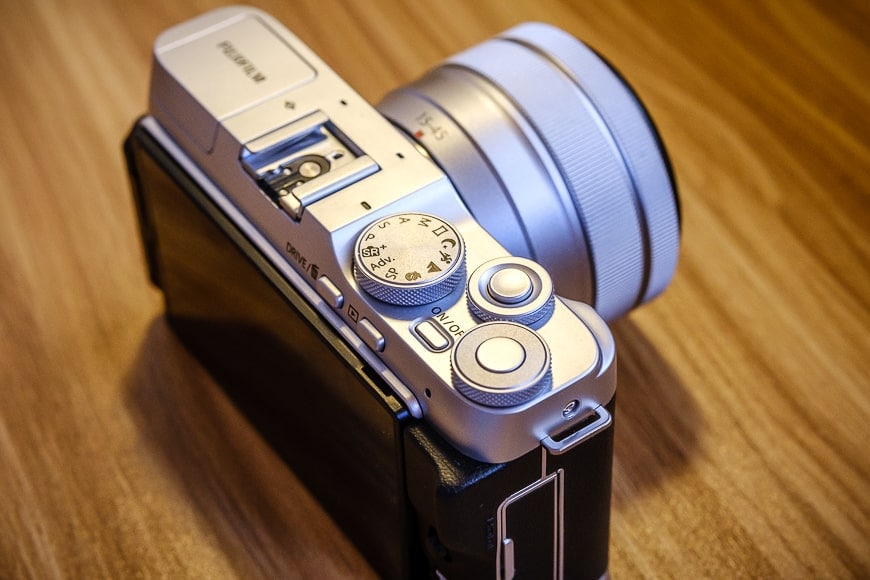
The Fujifilm X-A7 features a clutter-free design with minimal use of command dials and buttons.
There is no doubt that the Fujifilm X-A7 has a slick look and design. When you pick it up for the first time you will agree that it also has a great tactile feel, thanks to the material wrapping the camera and the minimal amount of buttons.
There is a lot to be said for a clutter-free control solution.
Thanks to a raised front grip and a rear thumb bump, the X-A7 is very comfortable to hold in hand even with a heavier Fujifilm lens attached.
Having only four buttons plus a small joystick on the rear of the camera means you are far less likely to hit the wrong one when shooting on the go. Each button is of adequate size and gives a reassuring click when pressed.
Interestingly, the menu system is almost split into two halves. The first is the standard and reliable Fujifilm menu for setting Image Quality, AF/MF, Shooting Settings and so on. All of the Fujifilm X Series cameras have basically the same menu system and this allows for ease of use if you choose to upgrade to a higher level camera.
This menu is accessed by a single press of the Menu/OK button on the rear of the camera. Navigating the menu can be achieved via the small rear joystick or through the use of the touch screen.
The touch screen option is incredibly accurate and responsive and I hope to see this implemented on all Fujifilm cameras.

The rear touch screen on the Fujifilm X-A7 has a 16:9 ratio and touch screen icons for menu functions
The second half of the menu on the Fujifilm X-A7 is a new addition for a Fujifilm camera. Via a set of icons on the regular touchscreen, you can access customisable features that are all touch responsive.
By default with this menu, you have icons to access the Q menu, touch screen focus, White Balance, Film Simulations and Focus Mode.
Two of the icons are actually customisable, and via the main menu, you can alter what features you have for quick access via the touch screen.
There is an icon to return to the standard screen and even a Question Mark icon to get a description of each icon.
With the Film Simulation icon, you can actually choose a certain film simulation and drag your finger left and right to see a before and after representation of how your image will look.
These touch screen features are clearly aimed at first-time digital camera shooters migrating up from a smartphone with touchscreen camera settings.
Fujifilm has created a fantastic system for the LCD touchscreen to swivel 180 degrees on both the horizontal and vertical axis. Flipping it on the vertical axis allows for the large screen to be house safely with the screen fitting snuggly against the body with the glass inwards.
Alternatively, the screen can be flipped around so that the camera can be used for selfies or vlogging.
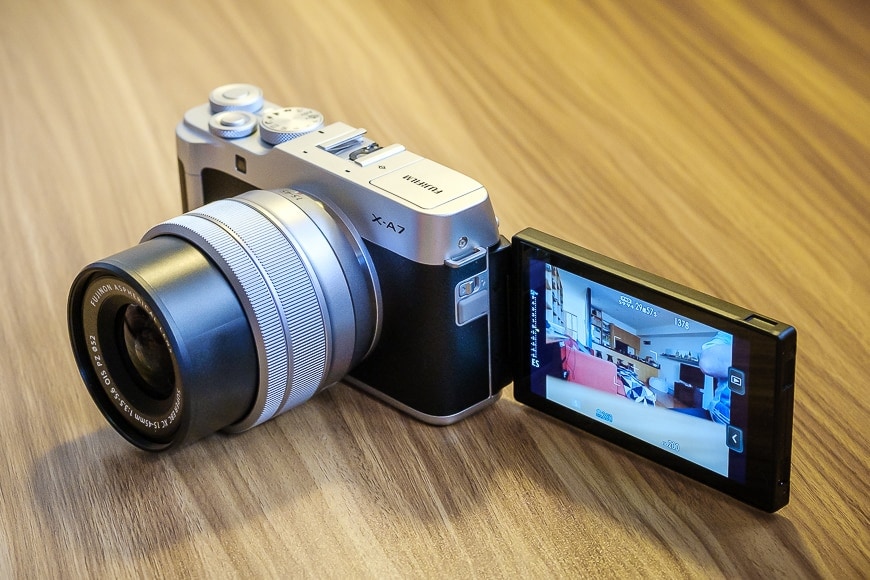
The Fujifilm X-A7 has a touch screen that rotates on the vertical and horizontal axis.
Focus Performance

Fujifilm X-A7 + Fujifilm XF 23mm f2 | 1/2000 f/2 ISO200
The Fujifilm X-A7 has a comprehensive set of autofocus modes and solutions depending on your shooting style. As with all current Fujifilm cameras, it features Face Detect with or without Eye Detect and Eye Priority.
The large touch screen can also be set to achieve focus with a quick tap of the screen. Further to this, it can be set to focus and shoot on a single touch, or if this is not your style then you can disable that feature completely.
This ‘touch to shoot’ feature is a great feature for those moving up from a smartphone to gain more photographic experience.
The touch screen autofocus system on the Fujifilm X-A7 feels like the most responsive and accurate that Fujifilm has installed on a camera to date.
Even in lower light, I found that using the touch screen to select a focal point was incredibly accurate – more than with any other Fujifilm camera I have used that has this feature.
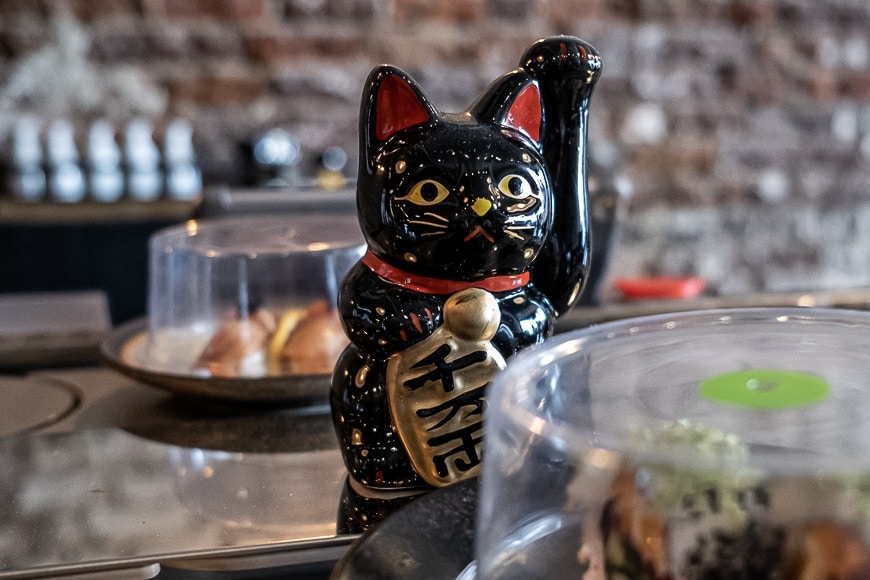
Fujifilm X-A7 + Fujifilm XF 23mm f2 | 1/250 f/3.2 ISO6400
Focus performance overall, including use of the touch screen and the shutter button, is very responsive, and only on rare occasions did I experience some focal hunting – this generally only happened when gaining focus in low light then quickly trying to grab focus in brighter light.
Of course, it will always depend on the type of lens you have attached to a camera, but in general, the Fujifilm X-A7 has a quick and snappy focusing system.
Low Light Performance

Fujifilm X-A7 + Fujifilm XF 23mm f2 | 1/125 f/8 ISO6400
I found no issues in shooting in low light conditions with the Fujifilm X-A7. In fact, Fujifilm has paid special attention to just how well this camera can perform in poor lighting conditions.
The ISO has a standard sensitivity range of 200 to 12,800 and an extended output sensitivity of 100 – 51,200.
It has three Auto ISO brackets to make ISO selection simpler, allowing the camera to make the best selection without going immediately to the extreme end of the scale.
However Fujifilm has not stopped there – they have included a built-in pop-up flash that is activated with the simple slide of a discreet button located on the side of the camera. The flash provides a decent amount of fill light in low light conditions without overexposing your subjects.
Fujifilm has also introduced a Light Trails Mode to its Scene Position mode accessible via the main command dial. This allows you to shoot long exposures simply and effortlessly.
Image Quality
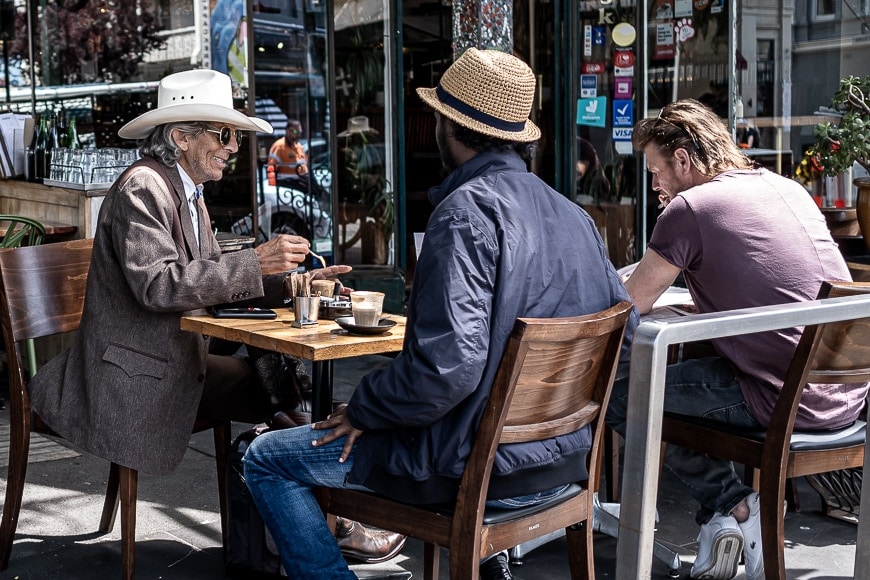
Fujifilm X-A7 + Fujifilm XF 23mm f2 | 1/500 f/2.5 ISO200
Whilst not sporting the flagship model’s latest X-Trans IV image sensor, the Fujifilm X-A7 still houses a healthy 24.2-megapixel CMOS image sensor, which is pulling in a large amount of information in all lighting conditions.
Shooting in JPEG, you will not be disappointed with the image quality produced by this camera. Fujifilm has spent decades as specialists in colour technology, and not just in the photographic and imaging business. They have fine-tuned their range of Film Simulations to provide pleasing, sharp and well-rendered images.
The Fujifilm X-A7 even encourages you to shoot and play with the Film Simulations, thanks to the sliding effect included in the large touch screen that shows a before and after image.
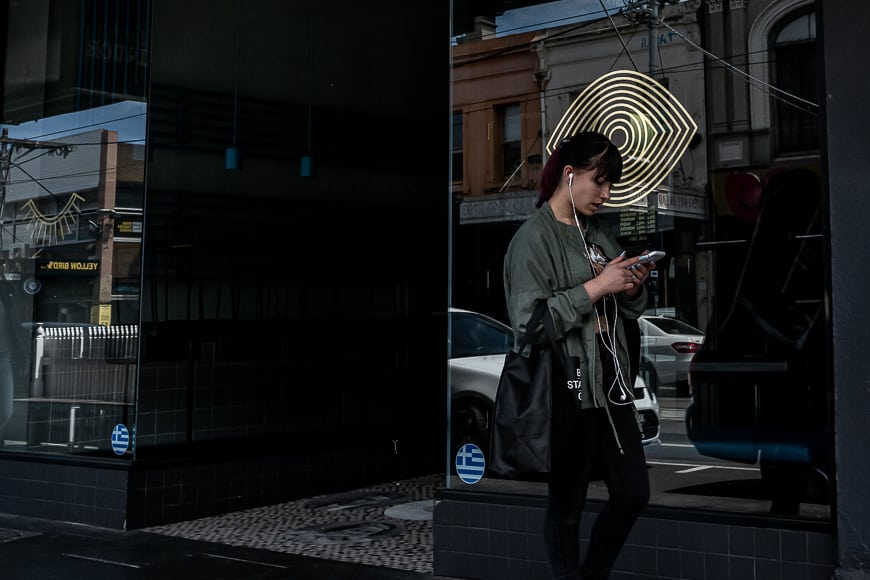
Fujifilm X-A7 + Fujifilm XF 23mm f2 | 1/1000 f/8 ISO200
As with all Fujifilm cameras, the X-A7 produces incredibly workable RAW files where even the darkest of images can be recovered in a suitable application, such as Lightroom.
If you are not sure if you want to shoot in JPEG or if RAW intimidates you a little, you can set the camera to capture one of each for the same image.
Overall Performance
The Fujifilm X-A7 provides a full complement of features, but given that it is an entry-level camera, it does not exceed in every area.
However given the price point and the demographic it is targeted towards, the camera does everything it promises to.
Whilst the touch screen response is the fastest I have seen on a Fujifilm camera, starting up the camera is a little slow and takes a noticeable moment before the screen lights up. However, this is not a big issue and certainly not something that would deter anyone from making the purchase or using this camera.
When shooting in a burst mode, the camera is able to achieve up to 6fps in Electronic Shutter mode. However, the buffer quickly stalls after only 4-5 images. This occurs when using either the Mechanical Shutter or the Electronic Shutter.
Other Useful Features
A great feature about the Fujifilm X-A7 is that it shoots video in either Full HD or in 4K. In Full HD (1920 x 1080), the camera will record at 59.94P continuous recording for up to 30 min. In 4K (3840 x 2160), the camera will record at 29.97P continuous recording, up to 15 min.
These are impressive options for those that love to shoot their own movies or are looking at using this camera for vlogging. What’s more, the camera is fitted with a hot-shoe that can fit an external mic along with the 2.5/3.5mm mic port and adaptor.
It is worth mentioning that the Fujifilm X-A7 is only available in a kit that comes with a Fujifilm XC 15-45mm f3.5-5.6 power zoom lens.
While it is great that Fujifilm has provided a bundled lens to allow new users to get into the photographic experience, this lens is a little disappointing when compared to the actual camera.
The lens is made entirely of plastic and has a power zoom that has proven to be slow to respond and travel from wide to zoom. Equally, the autofocus is sluggish and suffers from hunting in low light. I believe that the lens truly lets down the great performance of the camera.
Fortunately, anyone purchasing this camera also has access to the full range of X Series lenses, so upgrading to a more responsive lens is easy – check out some of the best Fuji lenses to attach to this camera.
Value for Money
Depending on where you are in the world, the Fujifilm X-A7 is available in Silver, Mint Green and Camel and bundles with the Fujifilm XF 15-45mm f3.5-5.6 lens for just around USD670.
For a complete camera system with the range of features available this is exceptional value for money.
A camera of this value makes great photography accessible for anyone willing to invest in a system that produces exceptional image quality and 4K video.
This camera has an enhanced range of tools and features that allows you to be fully creative with your photography.
As an entry-level camera, the Fujifilm X-A7 is a gateway product to the comprehensive line-up of Fujifilm cameras, and of course, its exceptional range of lenses.
Fujifilm X-A7 Review | Conclusion
The Fujifilm X-A7 is a perfect camera for entry-level photographers, in that it provides a perfect solution for those wanting to improve their photography game.
If you feel that your smartphone photography outcomes are no longer enough to satisfy your creative needs, then this camera will not disappoint.
The X-A7 provides a full range of well-designed and well-engineered photography tools that will appeal to those that are accustomed to shooting via a touch screen.
The touch screen on this camera is the biggest Fujifilm have ever implemented and is also the most responsive that Fujifilm has developed.
Using such a responsive touchscreen to shoot and edit your photos with, in combination with the wonderful collection of Fujifilm Film Simulations, is definitely a lot of fun, and the fact that this camera is affordable is the icing on the cake.

Compact and light, the X-A7 offers impressive performance at an affordable price.








